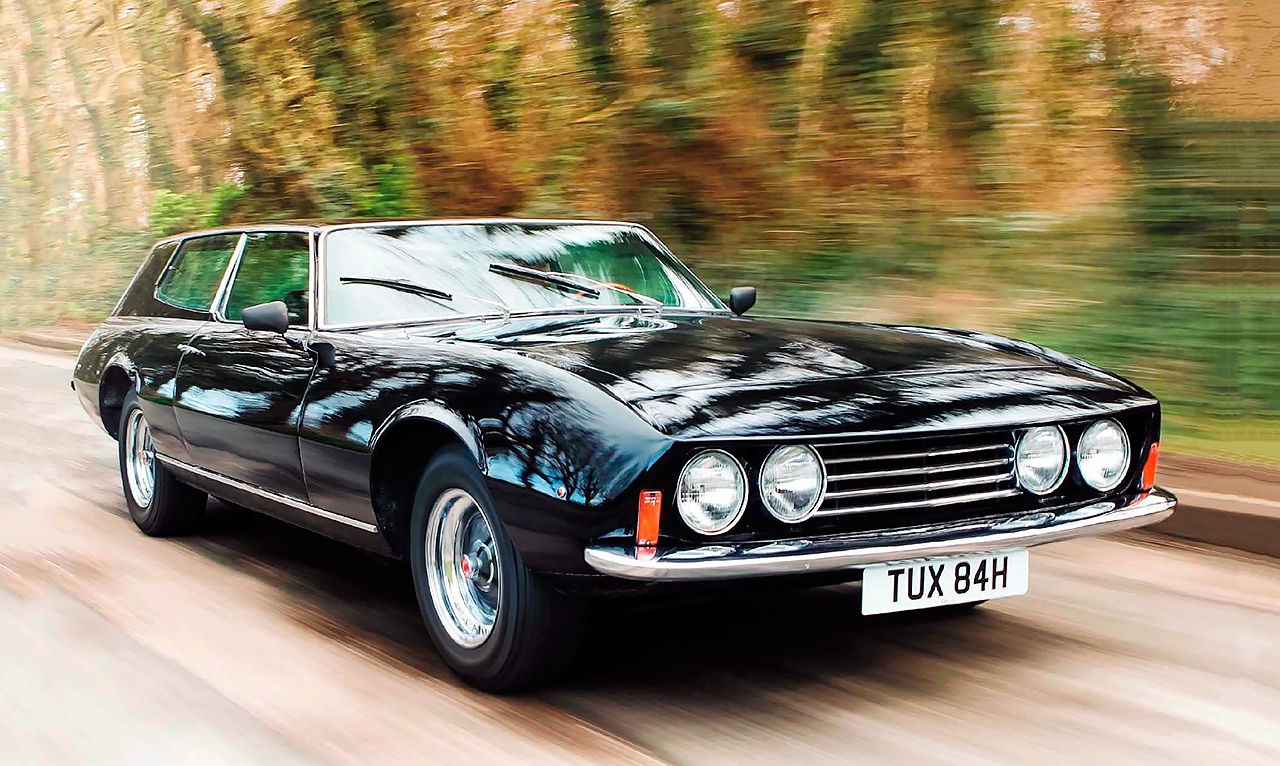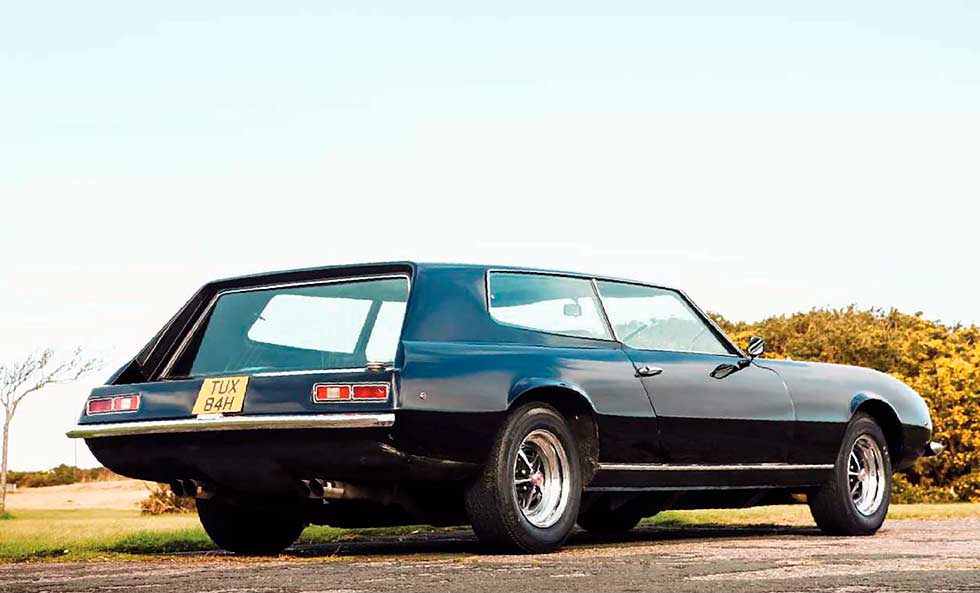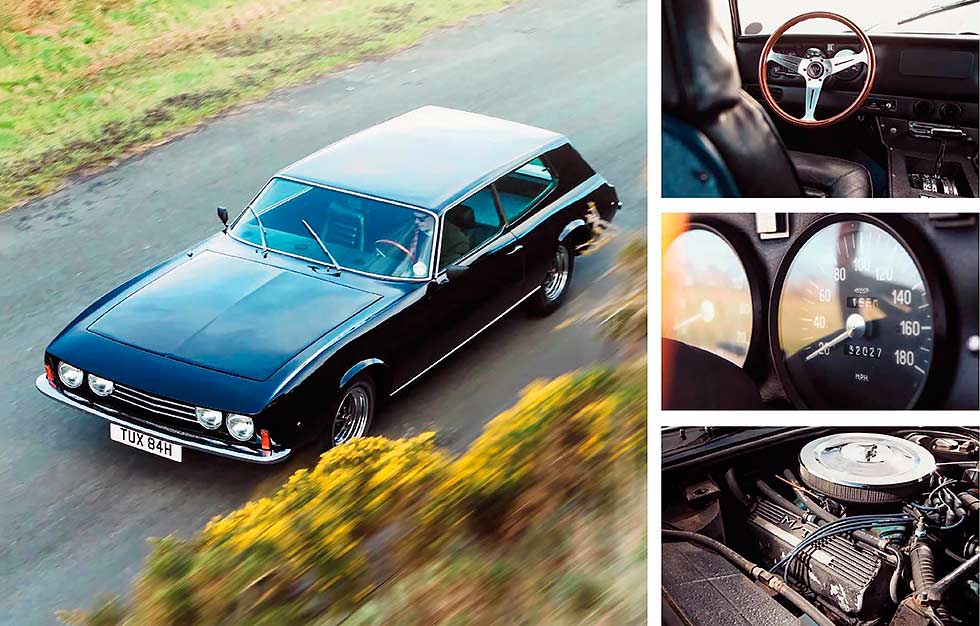
360bhp Murena 429GT driven Piste Beast. Murena 429GT We drive the 7.0-litre V8 behemoth whose remit was to combine Porsche driving appeal with estate car practicality and be cool enough to pick up girls. Built so two buddies could take their skis to the mountains and pick up girls, the Murena 429GT mixes outrageous styling with explosive performance. Words Richard Heseltine. Photography Lyndon McNeil.
With the benefit of hindsight, performing a 27-point turn outside prison gates in a jetblack Murena 429GT – a car that screams ‘gangster’ – maybe isn’t such a good idea. People are starting to notice. What’s more, they’re wearing uniforms and frowns and are probably packing Tasers – or possibly something even nastier.
My arrival was accompanied by an engine note that can probably be heard a mile or more away. And with dark clouds gathering overhead, now might be a good time to move along…
There are rarer cars than this Italian-US hybrid, but not many – a mere ten were made. There are prettier cars, but not many grab your attention in quite the same way. There are faster cars, but few are so entertaining as this 7033cc-engined monster. This was a machine built for the late-Sixties jet set, one that could match the acceleration of most pure-bred sporting exotics but also accommodate more than one passenger and their luggage – plus, importantly, their skis. It’s compelling, that’s for sure.
All of which seems a world away on a wet and windswept day in the environs of the former RAF base at Jurby that now houses the Isle of Man Prison. It isn’t the perfect locale to be exercising seven litres of angry V8 given the amount of standing water, but at least there’s little in the way of traffic.
Think of this car as a big-block Thunderbird in lingerie and you’re part way there. Today the car packs rather more horsepower than when it was created by Turinese artisans back in 1969. Nobody is sure of the precise output but it will spin its rear wheels without even trying, so it’s probably more than the factory-quoted 360bhp.

1969 Murena 429GT road test
What’s more, there’s little in the way of silencing and its chuggachugga soundtrack when cruising morphs into a bass growl when pressed. And you can say farewell to self-control – even the slightest pressure on the accelerator releases a pent-up fury guaranteed to widen your eyes and dilate your pupils.
On a straight and dry(ish) piece of road the Murena is laugh-out-loud fast for its size and vintage. The three-speed autobox is allied to a ludicrously large shifter that only adds to the sense of theatre. Put it into Drive and the tail squats, the nose rises in true powerboat style and heads turn in unison to discover the cause of the commotion. With such a monstrous engine in a car weighing just over 1700kg it’s no great shock that the 429GT moves with alacrity, but what comes as a great surprise is that it isn’t accompanied by a cacophony of creaks, groans and shudders. Driving over calloused asphalt the Murena irons out the worst of the bumps impressively, with little topographical nastiness being telegraphed back. It’s almost civilised. Almost.
There’s so much torque – about 480lb ft @ 2800rpm if the period stats are to be believed – that you’re never kept waiting for it to come on cam, unlike so many peaky, rev-happy exotics of the period. Corners, however, are a different kettle of understeer. The power-assisted steering isn’t exactly vague but it isn’t particularly responsive either. If anything, it feels heavier than you might expect at lower speeds. Turn in, and the weight transfer is palpable – and there’s fun to be had. Ultimately, the nose washes out first, and you really don’t want to get the tail flailing because it would probably take out a cottage or two before righting itself.
There are plenty of those around here, along with stone walls and hedgerows. All too soon it becomes a case of threading the needle, enthusiasm being tempered by the car’s generous proportions as roads take a turn for the narrow. This is clearly a car for the freeway, perhaps the autostrada, but not one for the Isle of Man’s back-of-beyond. If nothing else, it’s comfortable, with surprisingly good allround visibility despite the low seating position.
The 429GT is nothing if not a contradiction. The classic woodrimmed, alloy-spoked Nardi steering wheel and handsome Jaeger instruments scream Italian exotica, but the nondescript slab of dashboard and the view across an acreage of bonnet is more redolent of an American muscle car. Throw in exposed screw heads and Ford switchgear and it could only be a low-volume Sixties specialist product – yet it’s so much more than that.
There can be few car lovers who haven’t dreamed of creating their own bespoke machine built to very specific requirements, yet that’s what happened here. In fact the 429GT was meant to be even rarer than it is – the initial plan called for only two to be made, the main proviso being that they could accommodate skis.

7.0-litre V8 came courtesy of a tie-up with Ford. 180mph Jaeger speedometer is not overly optimistic. Controls respond softly to inputs, apart from the throttle. The pen behind the Alfa 33 Stradale was in a different mood when he designed the Murena.
At 250in from end to end, 76in wide and 50in high, the 429GT takes up a lot of space, and the choice of colour perhaps lends it a slightly funereal air. That said, the styling is uncluttered but far from empty. If anything, the lack of chrome marks it out from many other small-series offerings of the day.
What’s more, it was the work of Franco Scaglione. This gifted, if wayward, genius was responsible for umpteen landmark post-war Italian classics, his name being closely associated with Alfa Romeos such as the Giulietta Sprint, the Bertone BAT cars and the sublime Alfa Tipo 33 Stradale (perhaps his last unalloyed masterpiece). In the case of the Murena the Florentine artiste had a vast canvas to work with, but he succeeded in creating a two-door ‘sports wagon’ that didn’t appear utilitarian or slab-sided.
In modern-day parlance Murena would be a boutique brand, but the plaque adorning the driver’s-side sill alerts you to the fact that it wasn’t the manufacturer. It was actually built by Intermeccanica, which has produced a bewildering array of models from the late Fifties to the present day. These span everything from Formula Junior single-seaters to Checker-based neo-classics via luxury GTs and exacting VW Kübelwagen replicas and on more than one continent. And let’s not forget its involvement in countless projects as a sub-contractor, not least undertaking shooting brake and convertible conversions for mainstream Detroit fodder. Yet it’s a brand where myth and reality rarely seem to overlap, the Murena sub-species being a case in point.
The 429GT was conceived by Charlie Schwendler – whose father Bill was co-founder of the Grumman Aircraft Engineering Corporation – and marketing consultant (and sometime Marcos concessionaire) Joe Vos. The latter recalled in Andrew McCreddie’s Intermeccanica: The Story of the Prancing Bull that they were ‘…two nutty guys who wanted to drive around New York in fancy cars and pick up girls.’ That, and go on skiing trips.
He went on to add, ‘Charlie had a station wagon and a Porsche, and it was a compromise no matter which car we took into the mountains. In the wagon you had lots of room for gear but not a very enjoyable ride. In the Porsche the drive was great but we couldn’t fit much into it, so we thought it would be a great idea to build a car that did both.’
This ultimately led them to Intermeccanica after Vos cut short a skiing holiday in the Swiss Alps in February 1968 to check out the Turinese company. However, the relationship between would-be patron and company principal Frank Reisner didn’t get off to the best of starts – Vos received a cool reception at the factory after Reisner mistook him for a tax inspector.
With this wrinkle ironed out, a deal was struck in short order whereby ten cars would be made on the grounds that, since the skiing buddies were going to the trouble of building two cars, they might as well make ten and recoup their investment by selling the other eight. There was just the small matter of coining a suitable moniker for this brave new enterprise. The answer materialised during lunch between Vos and a Fiat executive while the New Yorker was staying in Turin’s exclusive Principi di Piemonte Hotel. Having ordered a seafood salad, he couldn’t identify one of the ingredients. His dining companion explained it was a particularly ferocious type of eel indigenous to Sardinia, called the murena. At a stroke Vos had a name for his creation.
By the time the prototype had been completed and displayed at the 1969 New York Auto Show, the scheme had changed out of all recognition to the point that the 429GT was set to go into series production, Vos stating he had received orders for 200 cars. In the September 1970 edition of Road & Track, however, this figure had been reduced to a more conservative 38 units. Whatever the truth, matters had clearly taken a turn for the serious.
With a list price of $14,950 (£6260 in 1969), at a time when a Ford Pinto cost $1919 (£803), the Murena was egregiously expensive considering its proletariat underpinnings. Nevertheless, the brochure talked up a storm, boasting of such features as ‘custommade self-levelling shock absorbers which really require a test ride to appreciate, cube lighting control panel with aircraft design and performance, built-in picnic tables, a serving pantry and bar with crystal service and a cruising range of 450 miles so you can have some time to enjoy driving’.
Independent reviews were mixed. The 1970 Motor Trend World Automotive Yearbook gushed, ‘The Murena GT [sic] exudes a “cost no object” aura that makes one and all feel as if they have been to the manor born. It is a most interesting design exercise that proves to be roadable as well… A Murena GT should be just the auto for fast touring across the desert in luxurious comfort, especially in those states that have few restrictive speed limits.’
Road & Track claimed its testers were unconvinced by the styling but added that, ‘Our impressions aside, public opinion was wildly favourable. The Murena engendered as close to 100 per cent enthusiasm as any car we have ever driven.’ Ominously, it added, ‘We were a bit alarmed by the clunks that came from the front suspension at the slightest road provocation; over dips and ramps the front end bottomed easily…
While the enthusiasm and potential is there, the Murena company has a long way to go to earn a place beside the other makes in the price range.’
By all accounts – and accounts are hard to come by – Elvis Presley bought two and legend has it that Frank Sinatra and Sammy Davis Jnr were also early adopters.
This ‘fact’ was culled from a dealer advertisement for a used Murena from way back when, so it may well be apocryphal. Nevertheless, it has been repeated ad infinitum ever since. What’s known for sure is that a member of rock band Iron Butterfly acquired one off the showroom floor in Beverly Hills, only to buy another shortly after colliding with an immovable object in the first.
The Murena also received a significant boost after Ford agreed to provide running gear at favourable rates. It also assisted the fledgling firm in homologating the 429GT. Ford boss Lee Iacocca was reputedly an admirer and went so far as to borrow a car (strictly for evaluation purposes, you understand).
Unfortunately, despite all the many positives, the scheme began to unravel almost immediately. Vos and Schwendler may have had a full order book, but they lacked a reliable supplier. Italy was in the midst of political and industrial turmoil and Intermeccanica was not immune. The stop-start nature of manufacture had knock-on effects and, with nothing approaching a production schedule in place, the partners threw in the towel. They were acutely aware of the bottom line and where it was located – and were not prepared to risk everything. The tenth and final 429GT was shipped to the United States in March 1970.
The Murena featured here was completed in December 1969. Its early history is unknown but Darren Cunningham acquired it in 2013 and it is on display in the remarkable Isle of Man Motor Museum. It isn’t the most unusual car in the collection, but it is among the most desirable exhibits if your tastes stretch to smallseries exotica.
The 429GT is two parts eccentric, one part eminently practical and wholly engaging. There was little like it in the late Sixties and there’s nothing really comparable now. Subtle it is not, but it sure strikes a chord.
Thanks to: Darren Cunningham (isleofmanmotormuseum.com)
TECHNICAL DATA 1969 Murena 429GT
Engine 7033cc V8, ohv, one Autolite 4V carburettor
Power and torque 360bhp @ 4600rpm; 480lb ft @ 2800rpm
Transmission Three-speed automatic, rear-wheel drive
Steering Rack and pinion, power-assisted
Suspension Front: independent, unequallength wishbones, coil-springs, self-levelling dampers. Rear: live axle, trailing arms, Panhard rod, coil springs, self-levelling dampers, anti-roll bar
Brakes Discs all-round
Weight 1710kg (3770lb)
Performance Top speed: 160mph (claimed); 0-60mph: 7.5sec
Fuel consumption 14mpg
Cost new $14,950 (£6260)
Values now £60,000-£70,000
‘If anything, the lack of chromework marks it out from many other small-series offerings of the day’
LIVING WITH A MURENA
Darren Cunningham is the adventurous type, having gone on US road trips in a Routemaster bus and initiated several daunting restoration projects. The Murena is one of more than 130 vehicles in the family collection.
‘I like quirky machines and have always had a bit of a thing for station wagons,’ he says. ‘I heard about this car via the Hooniverse website, having previously been in touch with the owner of another Murena that turned out to be a basket case and ridiculously overpriced. I haven’t done much to the car beyond maintaining it.
‘The Murena is relatively straightforward as exotic cars go because it’s largely Ford-based and a lot of parts are available off the shelf.
‘It has so many interesting features, but I suppose my favourite is the retractable rear screen. The funny thing is that it doesn’t actually go all the way down, so it isn’t a practical piece of design.
‘It’s an entertaining car to drive and, as far as I’m aware, this is the only one outside the USA.’
‘Think of it as a bigblock Thunderbird in lingerie and you’re part way there’





